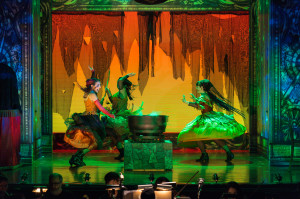
Maiden, Sorceress and Stepmother on Stage, Yiddish-Style
All strong women don’t have to be saintly. Some go about corralling the money they need to survive or to gain importance in brutal or deceitful ways, just as men do, in real life and in theater. We may not want to emulate them, but we have to consider them as part of a spectrum of interesting and important characters who transcend their archetypes. And largely, this production reminds us of that. “The Sorceress” is the star of a delightful “musical fantasy,” as the subtitle calls it, presented as a melodic fable in a polished production.

Image courtesy of National Yiddish Theatre Folksbiene
Set mainly in Romania, it also travels to Istanbul and contains a lot of old-fashioned comic relief. It is spoken and sung in Yiddish, with easy-to-read supertitles in English and Russian. The sets, costumes and cast, directed by Motl Didner, are first-rate, and the orchestra, led by musical director Zalman Mlotek, provides lively support for the singing and dancing. Yes, it is quaint, but that is fine.
Some spots, though, are a little discomforting despite Didner’s admirable accomplishment of keeping the tone as effervescent and comfortable as possible. This happens mainly in two plot turns. One involves the sale of Mirele (Jazmin Gorsline), the helpless ingenue, into slavery by her conniving stepmother (Rachel Botchan), who married Mirele’s wealthy father after possibly causing his first wife’s death, then got him arrested so she could take over his fortune. Mirele is shown being forced to beg, which is bad enough, but would this really have been sex slavery? The other problematic scene is one in which the villains, including the Sorceress herself (played with relish by Mihkl Yashinski)—all of them strong Jewish women, even if they are not likeable—burn to death. The scene reminded me of the Wicked Witch’s melting in “The Wizard of Oz,” so it wasn’t really gruesome. But are we supposed to cheer their deaths?
I also wondered about the age of Mirele, who is referred to often as a child, though she is engaged to a nice young man. Was she perhaps 13 in the original play, or a more reasonable age for marriage? What kinds of changes did the creators of this snappy 90-minute production (Didner, Mlotek and Dmitri Zisl Slepovitch, who provided additional orchestrations) make?
Instead of speculating, I called Didner to ask. Here are excerpts from our conversation:
How did you change the play for modern sensibilities?
The original text is quite a bit longer. The play would have run about twice long. We cut only one song, that seemed to be a tack-on. It was just stuck in there, and had nothing to do with the plot. The whole play tended to be very repetitive. It followed Shakespeare’s three-times rule, presenting the same information three times to make sure people heard it. When there was no amplification, people tended to chat a lot. It was a social occasion, like coming to synagogue on the High Holy Days, and missing something when shushing someone or asking, “What did he say?” Also, the original ended with the fire, the bad people burning and our good people getting rescued. We thought that in 2019 we shouldn’t end with death, so we ended with the wedding, which was promised at the beginning. We took another song by Goldfaden. “Mazl Tov,” from a different show. There was not much that we thought was sexist. The Ottoman number [when Mirele is enslaved in Istanbul] is historically correct. They did legally practice slavery until 1910. In this play, she was not a sexual slave, but it was certainly referencing the fear of enforced prostitution. The audience would have understood that.
What about the play’s tone? How would it have been played in the 1800s? More comic or more serious issues?
We really didn’t change very much. We don’t know how the original would have been geared. There are historic photos of other productions, but they run the gamut, from two-dimensional to classic staging. This was an important play. One of the touching moments here was on opening night. Our literary manager brought her aunt, a survivor, who remembered being in a production in 1946 in Lodz that starred Ida Kaminska, daughter of the great Polish impressaria Ester Rachel Kaminska.
How old is Mirele supposed to be? And what about her fiancé, Markus?
She’s 18. I think that’s what the original said. We didn’t want to specify, because we wanted to find the right actress for the role. Markus is about same age probably. By 18 people were getting married and having children.
What about the first scene, which shows Mirele’s mother dying and is done in pantomime like a silent movie?
We added the opening scene, because we figured it would be good to have a little bit of back story.
What do you find feminist or non-feminist in the original and now? Some characters are stereotypes: the helpless maiden, who needs help from her fiancé, the evil stepmother and stepsister, the evil witch.
It definitely plays on older tropes, in terms of the damsel in distress. There’s no question that it’s a product of its time. But in fact the women are leading forces, even if they’re on the wrong side. Bobe [the sorceress] and the others are a leading force. As opposed to a Lady Macbeth, who is manipulative, they are driving the action of the show. The ingenue is being battered about by the forces of their machinations. Even the handsome young hero doesn’t really do anything. Because he’s wealthy, he’s able to buy the father out [of his legal problems], but he doesn’t drive the story. They’re not powerful as the forces of good, but they are powerful.
The views and opinions expressed in this article are the author’s own and do not necessarily reflect those of Lilith Magazine.




